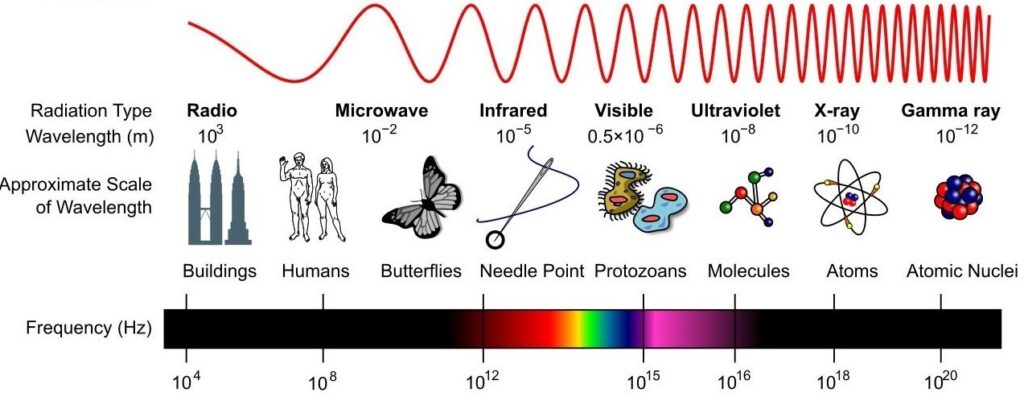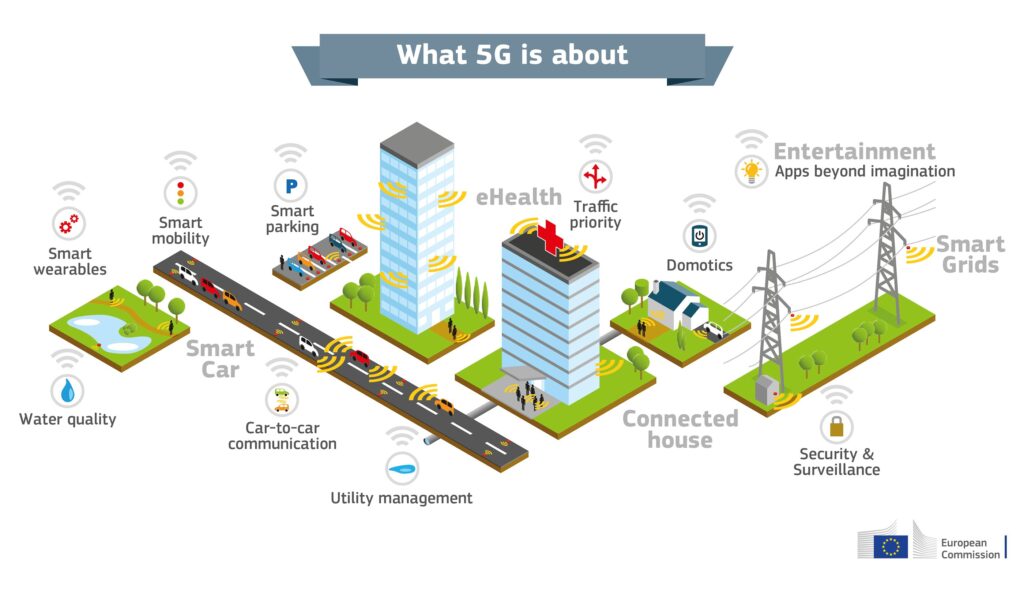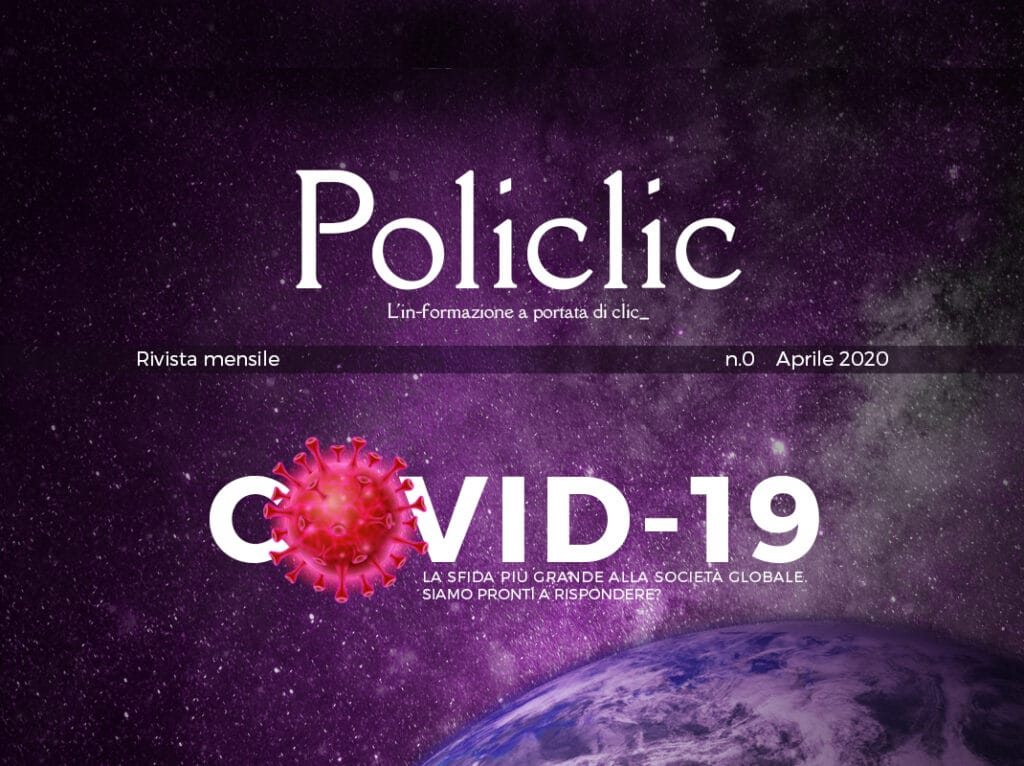Questo articolo è estratto dalla Rivista n.0 di Policlic pubblicata il 27 aprile. Scarica qui sotto la versione integrale.
Scarica QUI la Rivista n.0 di Policlic!
The introduction of the fifth generation standard for mobile communications has been a widely debated topic in recent times, both for the new opportunities offered by this novel generation of telecommunications and for its alleged effects on human health. While the growing public interest in the subject is undoubtedly a positive thing, and the resulting debate even enticing, there is nonetheless a non-negligible risk of misinformation. Such a risk exists, after all, every time matters of a purely technical-scientific nature are tackled with qualitative approaches, and without having the necessary knowledge and expertise.
Thus, it becomes important, if not essential, to take a step back and deal objectively with the topic of 5G from a technical perspective, ultimately going back to the facts, namely to the fundamentals of telecommunications systems and electromagnetic propagation. This is the goal of this article, which, however, is aimed at a broad audience and therefore has no claim of exhaustiveness. More specifically, this contribution has a twofold objective: on the one hand, to describe the main new features of 5G as compared to previous communication standards, both in terms of infrastructure and of characteristics of the used signals; on the other hand, to discuss the effects of the electromagnetic fields on biological systems (hence the possible consequences on human health), and the extent to which the fields associated with 5G will be different, compared to current standards, in relation to these aspects.
A step back
Before going into the characterization of the distinctive features of the fifth generation standard, it is worth taking a step back, focusing on a more general description of wireless communication systems and identifying their basic elements and parameters. In a nutshell, as the reader is surely aware, the objective of a wireless communication system is the transmission of data (in the form of bits, in current digital systems) from a source to a recipient by exploiting the propagation of electromagnetic signals through a physical channel, consisting of the space surrounding us. In order for this communication to be possible, the information (i.e., the bits to be transmitted) must be transferred, or impressed, into the electromagnetic signal that will be propagated. This fundamental operation, performed by each transmitter, is known as “modulation,” and the resulting electromagnetic wave is referred to as “carrier wave” (as it “carries” the information to be transmitted to the receiver). Telecommunications standards (such as 4G and 5G) have the task of defining all the necessary operations to properly process the electromagnetic signals carrying the information (which go well beyond modulation), both at the transmitter and at the receiver (which will have the task of recovering the data from the received signal). Moreover, the standards define the characteristics of the infrastructures and mobile terminals (for example the respective antennas). The ultimate goal is to guarantee a data transmission that meets specific requirements in terms of speed (quantity of data transmitted in the unit of time, in bits per second), energy consumption, latency (i.e., delay in transmission), and coverage.
An in-depth description of the specific signal processing techniques and infrastructures that guarantee the efficiency of wireless communications is out of the scope of this article.[1] However, it is important to outline at least two important parameters of the electromagnetic signals, which directly influence the performance of the communication systems at hand.
Transmitted power: The electromagnetic power radiated by the transmitting antenna (or antennas) is a particularly important parameter in telecommunications systems. It is easy to guess that a higher transmitted power corresponds to a higher received power and, accordingly, to a better signal quality and improved performance (although these do not grow linearly with the power). On the other hand, power is a limited resource, both for cost reasons (associated with energy consumption) and for physical limits of some hardware components, such as the amplifiers. Furthermore, it is crucial to limit the radiated electromagnetic power so as to comply with the thresholds imposed in relation to bioelectromagnetic interactions (which will be discussed later).
Frequency bands employed: A fundamental parameter that characterizes electromagnetic signals is their frequency band, namely the portion of the electromagnetic spectrum they occupy. Without going into details, and accepting some inevitable simplification, we can say that each electromagnetic wave is characterized by a certain frequency, or rather a set (or band) of adjacent frequencies, which are directly connected to the way the wave propagates in space: higher frequencies correspond to shorter wavelengths, i.e., to a higher spatial variation of the signals (in other words, higher frequency signals vary faster in space). For the sake of clarity, it is worth referring to the schematic representation of the electromagnetic spectrum in Figure 1, which shows the relation (of inverse proportionality) between frequencies (in Hertz) and respective wavelengths, as well as a (purely illustrative) representation of the corresponding signal in space. The figure also shows the different denominations of electromagnetic waves depending on the frequency bands they occupy, from radio waves, at lower frequencies, to gamma rays, characterized by extremely high frequencies. It is worth highlighting, as indicated in the figure, that visible light is also an electromagnetic wave, which occupies a band of frequencies well above the ones used in telecommunications systems (including 5G, as discussed later on), i.e., radio waves and microwaves.

Figure 1: Schematic representation of the electromagnetic spectrum, with reference to the types of radiation and the respective frequencies (in Hertz) and wavelengths (in meters).
The choice of the frequency bands to be employed in the various telecommunication standards is obviously far from random. The used frequencies are in fact characterized by technical and physical specifications that make them more or less suitable for different services, depending on the infrastructure. In general, a raise of the frequency corresponds to more available bandwidth, also due to a less congested spectrum by different services, and consequently to higher communication speed. At the same time, electromagnetic waves at high frequencies are subject to greater attenuation, so they cover shorter distances, and are also more easily shielded by the obstacles they encounter while propagating (for example walls and buildings). Ultimately, we can say that lower frequencies are more suited to guarantee larger coverage with lower capacity (achievable data transfer speed), while higher frequencies guarantee greater capacity in narrower areas, or cells. As can be easily understood, in this second case it is necessary to have a higher density of transmitters distributed over the territory to ensure a pervasive coverage, which is, however, facilitated by the smaller dimensions of the antennas (which decrease with increasing frequency).
Current mobile phone standards employ various frequencies of the electromagnetic spectrum according to the offered services. The 4G standard, in particular, uses different frequency bands, ranging from 600 MHz to 2.5 GHz.
The main novelties of 5G
The 5G standard, as the previous ones, has been developed by the scientific community and industry associations of the sector, and in particular by the industrial association 3GPP. The push towards the creation of a new telecommunication standard is linked to the need, on the one hand, to cope with the exorbitant growth of data traffic expected in the coming years (transfer of multimedia content, augmented reality, high definition, smart working), and, on the other hand, to allow the development of new network architectures in emerging areas, such as the so-called “Internet of things” (IoT), autonomous driving, and e-Health. The latter two require the simultaneous connection of a large number of devices, often with very stringent requirements in terms of latency, reliability, and energy consumption.

Figure 2: Applications of 5G. From https://ec.europa.eu/digital-single-market/en/towards-5g
The main aspects that differentiate 5G from previous standards in terms of performance are the following:
- extremely high data transmission speed, up to 100 times faster than 4G, with a potential peak bit-rate of 20 Gbps (Gigabit per second);
- latency (i.e., delay between a signal transmission and reception), up to 50 times lower than 4G, with particularly significant implications in fields such as autonomous vehicle driving and e-Health;
- high density of simultaneous connections, with considerable implications for the development of the IoT.
Such enhancements are made possible by a series of completely innovative features of 5G compared to current systems, from the point of view of both the transmitted signals and the infrastructures, as well as by extremely flexible and reconfigurable network architectures. Far from being exhaustive, some particularly relevant innovative elements are the following:
- Use of new frequency bands for the transmission, both at similar frequencies to previous standards (below 6 GHz) and at higher frequencies, in the millimeter wave band. Millimeter waves are electromagnetic waves characterized by wavelengths between one centimeter and one millimeter, or by frequencies between 30 GHz and 300 GHz (although also waves with frequencies slightly below 30 GHz are often referred to as millimeter waves). In many EU and non-EU countries the frequencies licensed for 5G systems are in the 700 MHz band, in the 3.7 GHz band, and in the 26 GHz band (but in some countries, such as China and Australia, higher frequencies, around 40 GHz, are also licensed). As previously discussed, having very different frequency bands available allows a high degree of flexibility, since low frequencies can be used to guarantee coverage over large areas with low traffic, while high (millimeter) frequencies guarantee high data rates (thanks to the larger available bandwidth) on areas with higher antenna density. It is worth highlighting that, in this second case, the use of a higher number of antennas distributed more densely over the territory also leads to a reduction in the transmitted power values, with a consequent improvement in energy efficiency.
- Use of multiple antennas, often in large numbers, both in transmission and in reception, implementing the so-called “massive MIMO” (multiple-input multiple-output). This type of architecture allows the exploitation of the spatial dimension (consisting in the different antennas jointly used) so as to make the transmission more efficient. More specifically, the presence of multiple antennas enables the so-called “beamforming,” a signal processing technique that concentrates the radiated electromagnetic power in the direction of the served users (which can be many simultaneously) and, consequently, avoids radiating waves where they are not needed. The advantage is double: improved energy efficiency (since no transmission power is wasted) and reduction of electromagnetic pollution.
- Possibility to use unlicensed frequency bands, namely not reserved for 5G and possibly reserved for other systems, through adaptive mechanisms of spectral coexistence. In other words, it is possible to use additional band reserved for other systems (such as some Wi-Fi networks) as long as the new system is adjusted to the licensed ones and does not interfere with them (for example, by transmitting only when the band in question is not occupied).
- A further possible development of the 5G standard is the integration with satellite networks, so as to ensure coverage in remote areas that are difficult to access for terrestrial infrastructure.
Effects on human health: are we in danger?
It is now time to tackle the thorny issue of the alleged effects of 5G signals on human health, thorny not so much for its intrinsic nature as for its being easily subject to misinformation phenomena.
The subject can be addressed by referring in general to electromagnetic radiations in the bands of radio waves and microwaves, i.e., with frequencies between 0 Hz and 300 GHz, the effects of which on biological systems have been studied for several decades. It should be noted that all telecommunications systems operate within this frequency range, so what is explained hereafter applies regardless of the specific communication standard considered. However, the peculiarities of the 5G standard will still be considered later on, in order to discuss whether and to what extent the conclusions change in the specific case.
First of all, to avoid confusion, it should be emphasized that the radiations under consideration, namely with a frequency up to 300 GHz, are non-ionizing radiations. This means that they do not carry enough energy to ionize atoms or molecules, i.e., to free electrons from them. This clarification is essential to distinguish the electromagnetic waves concerned, which, as already mentioned, have frequencies way below the ones of visible light, from ionizing radiation, such as X-rays and gamma rays (refer to the schematic representation of the electromagnetic spectrum introduced earlier), which have completely different mechanisms of interaction with matter.
Based on studies carried out over the past decades under the joint management of the World Health Organization (WHO) and the International Commission on Non-Ionizing Radiation Protection (ICNIRP), the only currently confirmed effects of non-ionizing radiation on biological systems are thermal effects. These effects are related to the overheating of human tissues exposed to radio waves (to varying degrees depending on the type of tissue), which can be harmful if the power of the waves exceeds certain thresholds. Therefore, following the studies conducted on the thermal effects, specific limits of exposure to electromagnetic fields have been introduced, in order to protect the population from any risks associated with these effects in the short, medium and long term. Such limits, introduced at EU level in the Recommendation of the European Council of 12 July 1999 (1999/519/CE), are regulated at national level in the various countries, which adopt them in a more or less conservative way. For the sake of clarity, it is worth explaining in more detail what the aforementioned exposure limits consist of: these are precise thresholds imposed, at the various frequencies under examination, on the electric field, magnetic field, and electromagnetic power density measured in any free environment. These quantities are directly related to each other, so it is common to refer only to the electric field, measured in V/m (Volts per meter). Just to provide a reference value, the limit set in the EU Recommendation for the electric field at frequencies above 2 GHz is 61 V/m. As already mentioned, the imposed limits are regulated nationally in each country, with some countries, such as Austria and the Netherlands, applying more lenient restrictions, and other ones, such as Italy and Poland, imposing stricter limits based on precautionary considerations (in Italy, for instance, the threshold for the electric field in inhabited centers is 6 V/m regardless of the frequency).[2] It is also important to highlight that these exposure limits are referred to the electromagnetic radiation present in the environment, and they must be respected independently of the specific operating telecommunications systems and the respective infrastructures installed on the territory, which of course have evolved in the last twenty years and will continue to evolve. Ad hoc measurement campaigns are conducted extensively to verify compliance with the limits, which in turn imposes constraints on the power radiated by the radio base stations.
Regarding non-thermal effects of electromagnetic fields on biological systems, i.e., effects associated with dynamics not related to tissue overheating, extensive research has been carried out over the years and there is currently no scientific evidence of long-term harmful effects for radiations that respect the said limits.
Having described the general framework regarding the interactions between non-ionizing radiation and human health, one might now wonder if something should be added in the specific case of the 5G standard. As a matter of fact, the answer would be negative, as the signals associated with 5G are fully comprised in the category of radiations discussed above, and consequently the same considerations and conclusions apply. The main concerns associated with the introduction of 5G certainly include the use of higher frequencies than the previous standards (the millimeter waves treated previously) and the growing number of antennas distributed throughout the territory. As for millimeter waves (with frequencies licensed around 26 GHz and, in some countries, around 40 GHz), besides stressing once again how they fall within the studied range, it should also be highlighted that their “penetration depth” in human tissues is even reduced compared to lower frequencies, as this depth decreases with increasing frequency (for non-ionizing radiations). As regards the growing number of antennas that will be used, and their higher densification on the territory, it has already been underlined that this actually entails a more efficient use of the radiated power, and consequently a reduction of power levels, especially whenever beamforming techniques are implemented. This suggests that 5G transmitters, even in high-density scenarios such as the Internet of Things, might even reduce the overall electromagnetic emission levels (which cumulatively take into account all the present devices) compared to previous standards. Therefore, mobile devices currently around us are likely to expose us to higher radiation levels than those associated with the antennas of future systems.
Of course, all the considerations above apply as long as the field levels in inhabited environments, as well as the electromagnetic emissions of mobile devices, are scrupulously monitored, so as to ensure that the imposed limits are not exceeded under any circumstances. It is also pivotal that the scientific community continues to conduct studies on the non-thermal effects of electromagnetic fields, which have been anyway going on for several years.
Ultimately, it should be emphasized that complex scientific subjects, such as the one under consideration, must necessarily be addressed in a quantitative and non-discursive fashion, in light of a careful analysis of the specific scenarios that uses the available theoretical and practical tools. Any attempt at simplifying or generalizing these matters is improper and can lead to conclusions far from reality. Furthermore, having Jacobin attitudes in such specialized areas inevitably leads to misinformation phenomena, which can have dangerous consequences in today’s hyper-connected society (ironically, thanks to telecommunication standards). In the writer’s opinion, it is totally fair and even normal to have doubts or to worry about new and unfamiliar technologies. Suffice it to think of how many people were afraid of the introduction of the first power plants in the late nineteenth century. After all, the tendency to fear what is not fully known and cannot be controlled is probably an innate characteristic of human beings, and certainly this is the case of technological development, which has a considerable influence in everyone’s life. To put it in Don DeLillo’s words, “as technology advances in complexity and scope, fear becomes more primitive.”[3] While this feeling of fear and uncertainty is understandable, it is nonetheless essential not to become victims of it but rather to channel it in the right direction, which is the direction of a critical and conscientious search for information, and an analysis of the findings in light of one’s knowledge and background. This certainly requires effort, but it is the only way not to feed a dangerous misinformation trend that often exploits and boosts our fears.
Danilo Spano per Policlic.it
Note
[1]The interested reader is referred to the following reference for details: D. Tse, P. Viswanath, Fundamentals of Wireless Communication, Cambridge University Press, 2005.
[2]Reference values for different countries can be found in: Comparison of international policies on electromagnetic fields, National Institute for Public Health and the Environment, RIVM, 2017.
[3]Conversations with Don DeLillo, edited by Thomas de Pietro, University Press of Mississippi, Ed. 2005.





